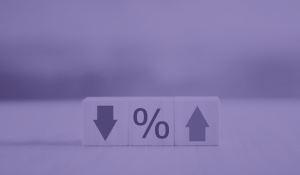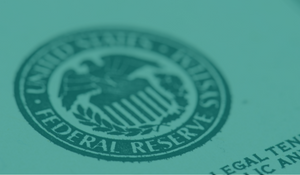With interest rate cuts on the horizon, it’s important to focus on what matters
Are we there yet?
The Fed’s latest interest rate hike raises important questions about our economy
The Fed took another step in its fight against inflation by raising its target policy interest rate another quarter point on Wednesday. This highly anticipated move has led to increased speculation as to whether rapidly rising interest rates may have peaked for now. Indeed, economic growth is slowing, inflation is softening, and financial conditions are tightening, which all help make the case that additional rate increases may not be necessary or wise.
But before speculating about the future, it’s worth reflecting on our recent economic past. About one year ago, the bottom level of the Fed’s target policy interest rate range was zero. A little over two years ago, inflation was hovering around 1%. And just over three years ago, no one had heard of a “pandemic stimulus check” nor had most ever imagined receiving one. Between swift COVID shutdowns and shaky re-openings, whipsaw economic growth, historic supply chain disruptions, rapid price surges, the fastest interest rate increases in 40 years, and some of the largest bank failures in history, the economic events we’ve experienced since the dawn of the decade have been nothing short of remarkable.
Any of these events on their own would be enough to rattle the most resolved investors—taken in totality, they might seem downright apocalyptic. Indeed, measures of sentiment reflect broad pessimism about our current economic situation and pundits continue to stoke popular fear. And yet, taking stock of our current economic situation with data, particularly in the context of what we’ve been through in the recent past, it is evident that our economic reality today is not entirely doom and gloom. Four major stories, all different but related, help us to see that things might not be as bad as they seem.
The first is inflation. Prices are still rising at a rate that is faster than ideal, with the CPI showing year-over-year inflation at a rate of 5.0% in March. But that is a steep drop from June 2022 when price growth had accelerated to a rate of 9.1%. The cost of goods and food items has largely stabilized as supply chain issues have resolved, and energy prices are down significantly over the past few months. Core services remain the primary driver of inflation, but the latest data show some relief in that category as well. While we’re hardly out of the woods, it seems that tighter economic conditions from higher interest rates and stricter credit standards from banks are having the effect of cooling broad price growth.
On a related note, the Fed’s restrictive monetary policy over the past year has been unsettling to markets. Its latest interest rate hike marks the 10th consecutive increase, with the pace of those hikes rivaling anything we’ve seen since the early 1980s. But its current target policy rate range of 5.00-5.25% is now at the level that Fed officials have predicted would be its “terminal” rate, and market indicators tend to agree. While language in the Fed’s latest statement left the door open to future rate hikes if the situation should call for it, it’s reasonable to assume that the aggressive program of rate increases is near its end, which points to a relatively more stable interest rate environment in the future.
The Fed’s interest rate increases also roiled the banking sector recently, as three relatively large banks failed due to balance sheet issues caused by the rapid change in rates. While these bank failures have led to short-term capital market volatility, the Fed’s establishment of a new Bank Term Funding Program and the FDIC’s extension of deposit insurance had the combined effect of swiftly protecting depositors and limiting broad contagion in the banking sector. The Fed admittedly made some mistakes in the leadup to these failures, and the full extent of bank troubles is yet to be known, but the banking system remains well-capitalized. Furthermore, this has had the effect of banks tightening credit standards, which ultimately aids in the Fed’s efforts to slow the economy and ease inflationary pressures.
Finally, while economic activity has slowed and inflation has eased, the economy is still growing at a slow but steady clip. Measures of growth for Q1 2023 show GDP rising at an annual pace of 1.1%, which was slightly below consensus estimates but far from the recession that many have predicted would manifest over the past year. Indeed, the most interest-rate sensitive areas of the economy are softening, with both new residential housing and business investment showing some declines this past quarter. But U.S. consumers continue to spend even in the face of rising prices, using increases in pay as well as some remaining accumulated pandemic savings and new credit to fund ongoing purchases. To riff on a line from the great Mark Twain, reports of the death of the U.S. economy are greatly exaggerated.
None of this is meant to discount the real risks posed by any of these factors. Might inflation buck the downward trend and rear its ugly head again? Might the Fed pass through the door it left open by continuing to raise interest rates rather than take an expected pause? Might more banks emerge with balance sheet issues that threaten their solvency? Might growth take a turn for the worse and send the economy into a recession? All of these present real possibilities of future potential issues for the U.S. economy and capital markets that could have real impacts on investors in the short-term.
Nonetheless, for long-term investors these risks are noise. Markets are likely to swing as active traders hang on every inflation report, job number, Fed rate release, and other daily developments. But the long-term growth prospects of the U.S. economy remain strong, as does the potential for disciplined and diversified investors to benefit from capital markets. We need only remind ourselves of how far we’ve come the last three years and what the data shows about where we stand today to understand that our future might be brighter than it seems.
-1.png?width=50&name=Untitled%20design%20(32)-1.png)


